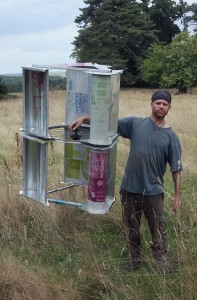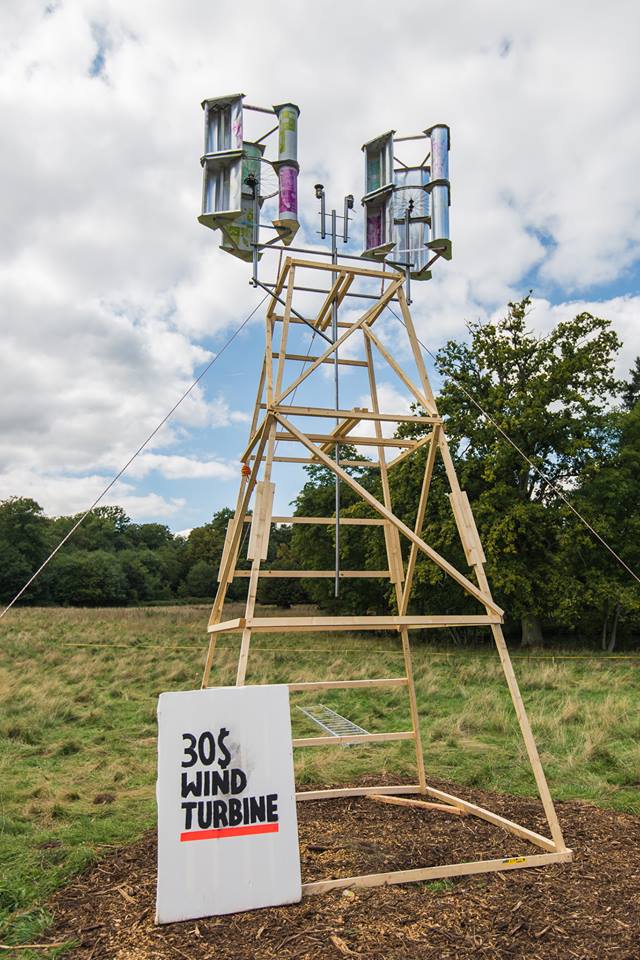“If you can cut and fold paper then you can make a wind turbine. It is really that simple. Plus, it’s very cheap, it will cost you maximum £30.”
The Earth is just over 4.5 billion years old, and sadly, for far too long we have been abusing its limited resources. The existence of human beings has caused an immense amount of destruction to natural habitats that were once home to a variety of species. Thankfully, there are people around the world who are trying to make a change – some doing so by using creativity, invention and their bare hands.
Daniel Connell is the leading example of such a person. Over the last few years, Daniel has been teaching people how to build their own wind turbines in the United Kingdom. A wind turbine usually has large blades that spin around and are directed by the wind. However, the base plate and bearing of Daniel’s turbines is based on a bike wheel and the blades are made from recycled aluminium offset printing plates. By using natural energy, such as the wind, Daniel’s turbines help to create electricity that can then be used for everyday needs. His design was one of the projects selected out of 177 to be presented at the climate change negotiations in Paris in December 2015.
According to him, DIY (Do It Yourself) is one of the most credible solutions to solving this damaging and perpetual situation that we are living in today.
“We have everything that we need to start, we just have to physically do the work. And if we do that, then we’ll probably end up somewhere quite nice but if we don’t then, that’s to our own risks.”
The 37-year-old inventor from New Zealand has a clear vision on how we can work collaboratively. It all began in 2013 when Daniel started to organise workshops, which eventually allowed him to make a living out of it by dedicating his time and energy to finding alternatives to renewable energy. He thought it was worth finding solutions for the planet and our future.
The green enthusiast explained how he started working with cheap materials and tools and that during the first year of his DIY project, SolarFlower, he was staying in squats and his cost of living was as low as 3-4 euros per day. This allowed him to keep SolarFlower going – and he now teaches DIY for a living. He said that it is the best way to spread information about the impact humans have on the environment.
Daniel’s most recent workshops teach people to make their own wind turbine. He spreads the word about these workshops mainly though social media and has organised them in cities such as London and Edinburgh. He said there has been a great mix of people from different backgrounds and occupations attending his workshops, some of whom he describes having “never held a drill before”. Despite this, he said that he has never had anyone struggle to take part in the workshops – whatever their level of DIY skill.
Daniel expressed his keen desire to work with young people more often, particularly engineering students who he described as being passionate about creating things.
“They showed huge interest when I organised a couple of workshops at the University of Edinburgh. I had to increase the size of the class from 15 to 50 [and] had a bunch of students who had to wait until the next year to attend because of room accommodation and schedule.”
Daniel believes that working more closely with universities would have a positive effect on young people, as well as himself. He said that he doesn’t believe that those who go to university necessarily graduate with a huge range of skills and abilities – he believes that the higher education system is tailored more to being “just about passing an exam”.
“I get slightly shocked sometimes. I ran a workshop in an university once where the students did the course specifically to do something practical – they wanted to do something hands on. As it turned out, my one-day workshop was literally the only time they have done anything practical in the entire course. They chose that degree because it was meant to be the most practical degree they could do, but it wasn’t practical at all.”
As crazy as it might sound to those of us who are in higher education or have already graduated with degrees, Daniel chose not to go to university. Instead, he had more of a “DIY education”, spending 18 months “just making things”, finding a project to work on and doing the necessary research for it. He said it has had a positive effect on him and his work because he’s doing what interests him and not something he didn’t want to learn.
“If you are not interested you are not going to make any effort in learning.”
According to Daniel, most people today in Western societies have a creative spiral that’s more of a hobby than something they’d actually consider doing in the long run. He stresses how “it’s because of the luxury of time needed”, thereby slowing down what has the potential of being an on-going constructive process.
“Everyone has to change. It’s doable – we just have to physically do it. This is the main problem; making material is relatively easy but creating it takes a lot of time. So we have the need on one side, we have the capacity other side, but in the middle we actually have to design it and that’s – by far – the struggle of the whole thing.”
DIY has the ability to create gradual change which can motivate and encourage us all to consider renewable energy more effectively. Daniel emphasises how it’s a better solution in terms of localisation because it uses less energy.
“[DIY] is a better solution and a better way of doing things: to produce everything as close to yourself geographically as you can. Also it’s just nicer, for us, living in the West, to produce energy and your own food – it’s a nicer way of doing things.”
Daniel sees DIY as a way of engaging people and making them more mindful and aware of their future, which hugely depends on resources that are extremely scarce. He explains: “We need to find models whereby we can get through, and the only model is radical localisation. We can still buy essential things such as food, energy and water but that’s not necessarily going to be the case forever.”
As hard as making a wind turbine might sound, Daniel describes it as a rather easy thing to do: “If you can cut and fold paper then you can make a wind turbine, it is really that simple. Plus, it’s very cheap, it will cost you maximum £30.”
Daniel declares that people won’t start doing something if they don’t already know how to do it and that is one of the biggest problems. He stresses: “We have everything but we need to do it.”
To find out more about Solarflower’s work or watch one of Daniel’s tutories, visit his website.



